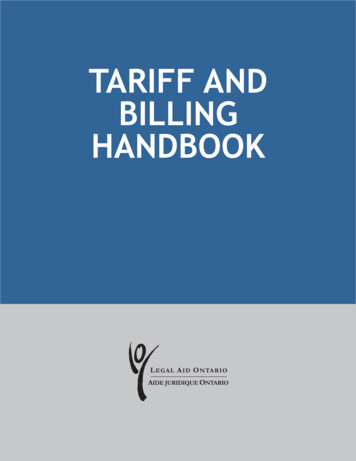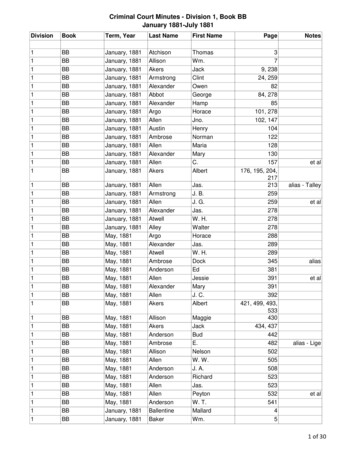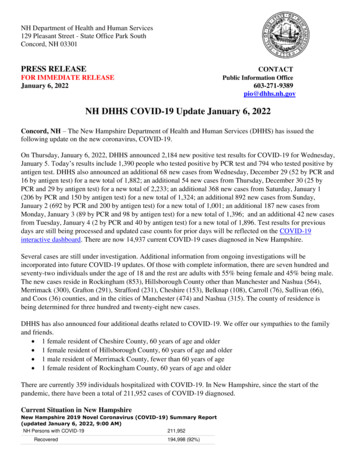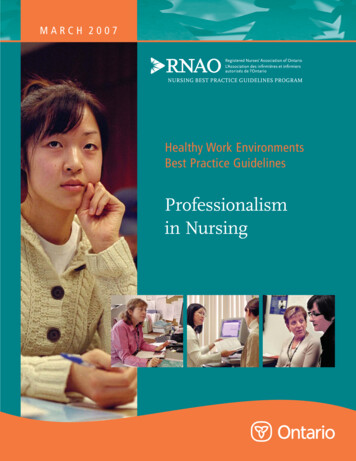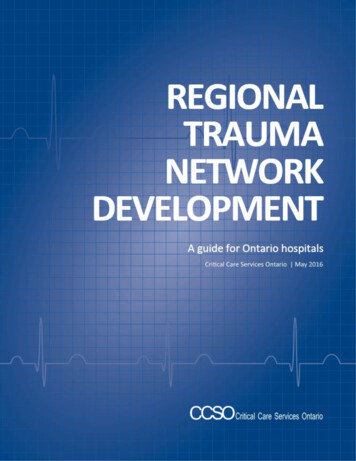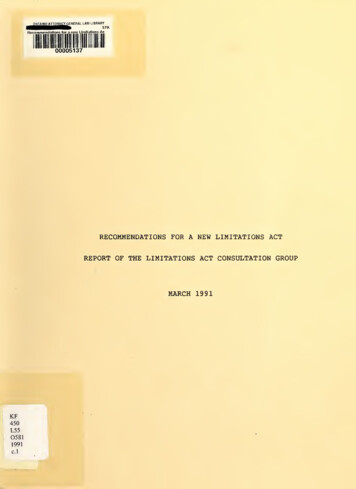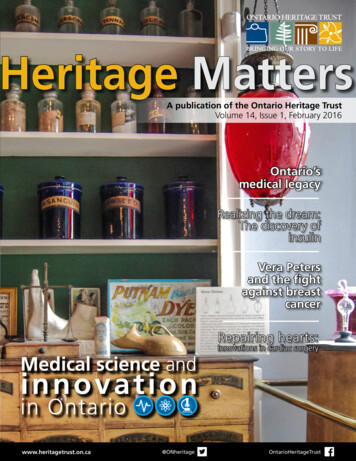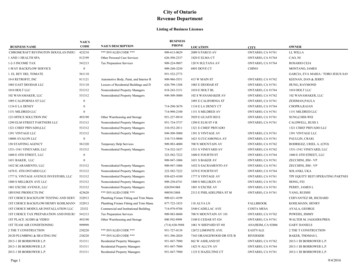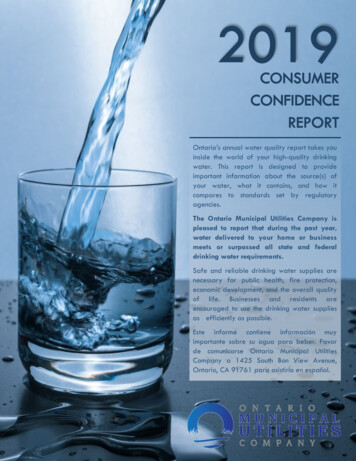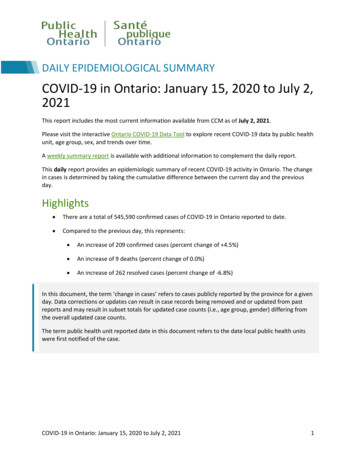
Transcription
DAILY EPIDEMIOLOGICAL SUMMARYCOVID-19 in Ontario: January 15, 2020 to July 2,2021This report includes the most current information available from CCM as of July 2, 2021.Please visit the interactive Ontario COVID-19 Data Tool to explore recent COVID-19 data by public healthunit, age group, sex, and trends over time.A weekly summary report is available with additional information to complement the daily report.This daily report provides an epidemiologic summary of recent COVID-19 activity in Ontario. The changein cases is determined by taking the cumulative difference between the current day and the previousday.Highlights There are a total of 545,590 confirmed cases of COVID-19 in Ontario reported to date. Compared to the previous day, this represents: An increase of 209 confirmed cases (percent change of 4.5%) An increase of 9 deaths (percent change of 0.0%) An increase of 262 resolved cases (percent change of -6.8%)In this document, the term ‘change in cases’ refers to cases publicly reported by the province for a givenday. Data corrections or updates can result in case records being removed and or updated from pastreports and may result in subset totals for updated case counts (i.e., age group, gender) differing fromthe overall updated case counts.The term public health unit reported date in this document refers to the date local public health unitswere first notified of the case.COVID-19 in Ontario: January 15, 2020 to July 2, 20211
Case CharacteristicsTable 1a. Summary of recent confirmed cases of COVID-19: OntarioChange incasesJuly 1, 2021Change incasesJuly 2, 2021Percentage changeJuly 2, 2021compared to July 1,2021Cumulative casecountas of July 2, 2021200209 4.5%545,590Number of deaths990.0%9,205Number resolved281262-6.8%534,272Total number of casesNote: The number of cases publicly reported by the province each day may not align with case counts reported topublic health on a given day; public health unit reported date refers to the date local public health was firstnotified of the case. Data corrections or updates can result in case records being removed and or updated frompast reports.Data Source: CCMCOVID-19 in Ontario: January 15, 2020 to July 2, 20212
Table 1b. Summary of recent confirmed cases of COVID-19 by age group and gender: OntarioChange in casesJuly 1, 2021Change in casesJuly 2, 2021Cumulative case countas of July 2, 2021Gender: Male104109271,848Gender: Female8996269,959Ages: 19 and under475787,869Ages: 20-397183204,342Ages: 40-594642155,693Ages: 60-79281972,484Ages: 80 and over8725,102Note: Not all cases have a reported age or gender reported. Data corrections or updates can result in case recordsbeing removed and or updated from past reports and may result in subset totals (i.e., age group, gender) differingfrom past publicly reported case counts.Data Source: CCMTable 2. Summary of recent confirmed cases of COVID-19 in school aged children by agegroup, August 30, 2020 to July 2, 2021: OntarioChange in casesJuly 1, 2021Change in casesJuly 2, 2021Cumulative case countfrom August 30, 2020to July 2, 2021Ages: 4 to 8101816,249Ages: 9 to 1315820,346Ages: 14 to 1711820,710Note: Includes all confirmed cases of COVID-19 for specified ages, regardless of school attendance. Datacorrections or updates can result in case records being removed and or updated from past reports and may resultin subset totals (i.e., age group) differing from past publicly reported case counts.Data Source: CCMCOVID-19 in Ontario: January 15, 2020 to July 2, 20213
Table 3. Summary of recent confirmed cases of COVID-19 in long-term care homes: OntarioChange in casesJuly 1, 2021Change in casesJuly 2, 2021Cumulative case countas of July 2, 2021Residents3115,399Health care workers017,195Deaths among residents003,970Deaths among health careworkers0010Long-term care home casesNote: Information on how long-term care home residents and health care workers are identified is available in thetechnical notes. Also, the change in cases in these categories may represent existing case records that have beenupdated.Data Source: CCMCOVID-19 in Ontario: January 15, 2020 to July 2, 20214
TimeFigure 1. Confirmed cases of COVID-19 by likely acquisition and public health unit reported date: Ontario, January 15, 2020 to July2, 2021Data Source: CCMCOVID-19 in Ontario: January 15, 2020 to July 2, 20215
Figure 2. Confirmed cases of COVID-19 by likely acquisition and approximation of symptom onset date: Ontario, January 15, 2020to July 2, 2021Note: Not all cases may have an episode date and those without one are not included in the figure. Episode date is defined and available in the technical notes.Data Source: CCMCOVID-19 in Ontario: January 15, 2020 to July 2, 20216
Figure 3. Number of COVID-19 tests completed and percent positivity: Ontario, March 29, 2020 to July 1, 2021Note: The number of tests performed does not reflect the number of specimens or persons tested. More than one test may be performed per specimen or perperson. As such, the percentage of tests that were positive does not necessarily translate to the number of specimens or persons testing positive.Data Source: The Provincial COVID-19 Diagnostics Network, data reported by member microbiology laboratories.COVID-19 in Ontario: January 15, 2020 to July 2, 20217
SeverityFigure 4. Confirmed deaths among COVID-19 cases by date of death: Ontario, March 1, 2020 to July 2, 2021Note: Cases without a death date are not included in the figure.Data Source: CCMCOVID-19 in Ontario: January 15, 2020 to July 2, 20218
Table 4. Confirmed cases of COVID-19 by severity: OntarioCumulative case countas of July 2, 2021Percentage of allcases9,2051.7%Deaths reported in ages: 19 and under4 0.1%Deaths reported in ages: 20-3982 0.1%Deaths reported in ages: 40-595780.4%Deaths reported in ages: 60-792,9354.0%Deaths reported in ages: 80 and over5,60522.3%Ever in ICU5,3741.0%Ever hospitalized27,9435.1%Blank cellCumulative deaths reported (please note there maybe a reporting delay for deaths)Note: Not all cases have an age reported. Data corrections or updates can result in case records being removedand/or updated and may result in totals differing from past publicly reported case counts.Data Source: CCMCOVID-19 in Ontario: January 15, 2020 to July 2, 20219
GeographyTable 5. Summary of recent confirmed cases of COVID-19 by public health unit and region:OntarioChange incasesJuly 1, 2021Change incasesJuly 2, 2021Cumulativecase countCumulative rateper 100,000populationNorthwestern Health Unit101,0911,244.4Thunder Bay District Health Unit1-23,3372,225.3TOTAL NORTH WEST2-24,4281,863.4Algoma Public Health00400349.5North Bay Parry Sound DistrictHealth Unit31606467.0Porcupine Health Unit452,0742,485.6Public Health Sudbury & Districts122,1481,079.3Timiskaming Health Unit00208636.3TOTAL NORTH EAST885,436971.9Ottawa Public Health51127,6732,623.9Eastern Ontario Health Unit2-74,6102,208.8Hastings Prince Edward PublicHealth001,133672.4Kingston, Frontenac and Lennox& Addington Public Health3-11,549728.2Leeds, Grenville & Lanark DistrictHealth Unit101,7521,011.7Renfrew County and DistrictHealth Unit11744684.9TOTAL EASTERN12437,4611,944.6Public Health Unit NameCOVID-19 in Ontario: January 15, 2020 to July 2, 202110
Change incasesJuly 1, 2021Change incasesJuly 2, 2021Cumulativecase countCumulative rateper 100,000populationDurham Region HealthDepartment3625,2313,541.7Haliburton, Kawartha, Pine RidgeDistrict Health Unit152,1701,148.5Peel Public Health2112109,5006,818.4Peterborough Public Health811,5921,075.8Simcoe Muskoka District HealthUnit3612,3812,064.9York Region Public Health9452,6214,292.8TOTAL CENTRAL EAST4534203,4954,541.6Toronto Public Health2320165,0585,289.7TOTAL TORONTO2320165,0585,289.7Chatham-Kent Public Health001,8841,772.1Grey Bruce Health Unit18201,633961.2Huron Perth Public Health221,9311,381.7Lambton Public Health233,6052,752.7Middlesex-London Health Unit14212,5762,477.9Southwestern Public Health313,8831,836.0Windsor-Essex County HealthUnit31116,8663,970.1TOTAL SOUTH WEST423942,3782,506.4Brant County Health Unit1-13,8542,483.2City of Hamilton Public HealthServices8821,2743,592.6Haldimand-Norfolk Health Unit012,6802,349.2Public Health Unit NameCOVID-19 in Ontario: January 15, 2020 to July 2, 202111
Change incasesJuly 1, 2021Change incasesJuly 2, 2021Cumulativecase countCumulative rateper 100,000populationHalton Region Public Health122217,4092,812.0Niagara Region Public Health22016,2413,437.4Region of Waterloo Public Healthand Emergency hPublic Health498,1992,628.7TOTAL CENTRAL WEST6810687,3343,065.1TOTAL ONTARIO200209545,5903,670.4Public Health Unit NameNotes: Health units with data corrections or updates could result in records being removed from totals, leading tonegative or zero counts.Data Source: CCMCOVID-19 in Ontario: January 15, 2020 to July 2, 202112
OutbreaksTable 6. Summary of recent confirmed COVID-19 outbreaks reported in long-term carehomes, retirement homes and hospitals by status: OntarioInstitution typeChange inoutbreaksJuly 1, 2021Change inoutbreaksJuly 2, 2021Number ofongoingoutbreaksCumulative number ofoutbreaks reportedLong-term care homes0031,485Retirement homes003871Hospitals127575Note: Ongoing outbreaks include all outbreaks that are ‘Open’ in CCM without a ‘Declared Over Date’ recorded, orwhere the outbreak started more than five months ago, even for outbreaks where the Outbreak Status valueselected in CCM is 'OPEN'. The start of the outbreak is determined by the onset date of first case, or if missing theoutbreak reported date, or else if that is also missing, then the outbreak created date.Data Source: CCMCOVID-19 in Ontario: January 15, 2020 to July 2, 202113
Variant COVID-19 CasesThe laboratory detection of a variant of concern (VOC) is a multi-step process. Samples that test positive for SARS-CoV-2 and have a cycle threshold (Ct)value 35 can be tested for mutations common to variants of concern. If positive for the mutation of interest with a Ct value of 30, these samplesmay then undergo genomic analyses to identify the VOC lineage. VOC lineages may still be confirmed using genomic analysis despite specific S genemutation(s) being documented as ‘unable to complete’ due to poor sequence quality at the genome position. For more information about wholegenome sequencing, please see the SARS CoV-2 Whole Genome Sequencing in Ontario report.Figure 5. Number of confirmed COVID-19 cases and percent positive for mutations or VOCs: Ontario, February 7, 2021 to July 2, 2021COVID-19 in Ontario: January 15, 2020 to July 2, 202114
Note: Data used to calculate the number of cases tested for mutations common to VOCs or lineages using genomic analyses are obtained using information from theLaboratory object in CCM in addition to the data from the Investigation Subtype field. Therefore, comparisons to counts using only information from the InvestigationSubtype field may not align. The percent of cases due to a VOC may be higher than described in this report.*The denominator includes only confirmed COVID-19 cases that were able to be tested for VOCs (e.g. those identified as ‘Detected’ or ‘Not Detected’). Mutationstested for routinely are the N501Y and E484K mutations. Mutations common to the B.1.617.2 lineage are not included in the current VOC mutation test. However,cases identified as B.1.617.2 after whole genome sequencing is completed are included in the VOC detected category.**The denominator includes all confirmed COVID-19 cases, including those that were unable to be tested for VOCs (e.g. those identified as ‘Detected’, ‘Not Detected’and ‘Not Tested/Unable to Complete Testing’).Data Source: CCMCOVID-19 in Ontario: January 15, 2020 to July 2, 202115
Table 7. Summary of confirmed COVID-19 cases with a mutation or VOC detected: OntarioChange in casesJuly 1, 2021Change in casesJuly 2, 2021Cumulative case countup to July 2, 2021Lineage B.1.1.7 (Alpha)*15734143,867Lineage B.1.351 (Beta)**2801,415Lineage P.1 (Gamma) ***3334,631Lineage B.1.617.2 (Delta)†48322,027N501Y and E484K-42-14,705N501Y (E484K unknown)‡-119-413,954E484K (N501Y negative)055,807E484K (N501Y unknown)-1-34561161911,686Variant of ConcernMutationsMutation not detected§Note: Interpret the VOC and mutation trends with caution due to the varying time required to complete VOCtesting and/or genomic analysis following the initial positive test for SARS-CoV-2. Due to the nature of the genomicanalysis, test results may be completed in batches. Data corrections or updates can result in case records beingremoved and/or updated and may result in totals differing from past publicly reported case counts. Data forcalculating the change in cases and the cumulative case counts uses data from the Investigation Subtype field only.Changes to the VOC testing algorithm may impact counts and trends. Further details can be found in the datacaveats section.*Includes all confirmed COVID-19 cases where lineage B.1.1.7 was identified by genomic analysis and thosepresumed to be B.1.1.7 based on positive N501Y and negative E484K mutation in the Investigation Subtype field**Includes B.1.351 cases identified by genomic analysis and those presumed to be B.1.351 based on ‘MutationK417N and N501Y and E484K ’ in the Investigation Subtype field***Includes P.1 cases identified by genomic analysis and those presumed to be P.1 based on ‘Mutation K417T and N501Y and E484K ’ in the Investigation Subtype field†Includes B.1.617.2 cases identified by genomic analysis. Mutations common to B.1.617.2 are not included in thecurrent VOC mutation test.‡The category ‘N501Y (E484K unknown)’ mainly consists of results from before the introduction of the E484K test.Counts will shift from this category into a VOC lineage category as E484K tests or genomic analysis are completed.§Includes cases identified as ‘Mutation not detected’ or ‘Mutation N501Y- and E484K-‘ in the Investigation Subtypefield only.Data Source: CCMCOVID-19 in Ontario: January 15, 2020 to July 2, 202116
Figure 6. Confirmed COVID-19 cases with a mutation or VOC detected by public health unit reported date: Ontario, November 29, 2020to July 2, 2021Note: Reported date is based on the date the case was reported, not the date that the VOC or mutation was identified. Further details on testing for variants ofconcern can be found in the technical notes. Interpret the VOC and mutation trends with caution due to the varying time required to complete testing and/or genomicanalysis following the initial positive test for SARS-CoV-2. Data for calculating the change in cases and the cumulative case count uses data from the InvestigationCOVID-19 in Ontario: January 15, 2020 to July 2, 202117
Subtype field only. Data for cases with a B.1.1.7, B.1.351, P.1 and B.1.617.2 lineage detected or any of the mutations listed above are determined using theInvestigation Subtype field only. Changes to the VOC testing algorithm may impact counts and trends. Further details can be found in the data caveats section. As ofMarch 22, 2021, positive specimens with a Ct 35 are tested for both the N501Y and E484K mutation, with all E484K positive specimens with a Ct 30 forwarded forfurther genomic analysis. If found to be positive for the N501Y mutation only, no further genomic analysis are performed as these are presumed to be B.1.1.7. As ofMay 26, 2021, cases where an E484K mutation is detected will no longer be reflexed for sequencing as VOC testing labs switched to a representative sampling methodwhere only a proportion of all positives with a Ct 30 are forwarded for further genomic analysis.*Includes all confirmed COVID-19 cases where lineage B.1.1.7 was identified by genomic analysis and those presumed to be B.1.1.7 based on positive N501Y andnegative E484K mutation in the Investigation Subtype field**Includes B.1.351 cases identified by genomic analysis and those presumed to be B.1.351 based on ‘Mutation K417N and N501Y and E484K ’ in the InvestigationSubtype field***Includes P.1 cases identified by genomic analysis and those presumed to be P.1 based on ‘Mutation K417T and N501Y and E484K ’ in the Investigation Subtypefield†Includes B.1.617.2 cases identified by genomic analysis. Mutations common to B.1.617.2 are not included in the current VOC mutation test.‡The category ‘N501Y (E484K unknown)’ mainly consists of results from before the introduction of the E484K test. Counts will shift from this category into a VOClineage category as E484K tests or genomic analysis are completed.§Includes cases identified as ‘Mutation not detected’ or ‘Mutation N501Y- and E484K-‘ in the Investigation Subtype field only.Data Source: CCMCOVID-19 in Ontario: January 15, 2020 to July 2, 202118
Technical NotesData Sources The data for this report were based on information successfully extracted from the Public HealthCase and Contact Management Solution (CCM) for all PHUs by PHO as of July 2, 2021 at 1 p.m.for cases reported from February 1, 2021 onwards and as of July 2, 2021 at 9 a.m. for casesreported up to January 31, 2021. VOC data for this report were based on information successfully extracted from CCM for allPHUs by PHO as of July 2, 2021 at 1 p.m. for cases reported from April 1, 2021 onwards and asof July 2, 2021 at 9 a.m. for cases reported up to March 31, 2021. CCM is a dynamic disease reporting system, which allows ongoing updates to data previouslyentered. As a result, data extracted from CCM represent a snapshot at the time of extractionand may differ from previous or subsequent reports. Ontario population projection data for 2020 were sourced from Ministry, IntelliHEALTH Ontario.Data were extracted on November 26, 2019. COVID-19 test data were based on information from The Provincial COVID-19 DiagnosticsNetwork, reported by member microbiology laboratories.Data Caveats The data only represent cases reported to public health units and recorded in CCM. As a result,all counts will be subject to varying degrees of underreporting due to a variety of factors, such asdisease awareness and medical care seeking behaviours, which may depend on severity ofillness, clinical practice, changes in laboratory testing, and reporting behaviours. Data cleaning for older cases is incorporated on Mondays and may impact the case countpublished on Tuesdays Lags in CCM data entry due to weekend staffing may result in lower case counts than wouldotherwise be recorded. Only cases meeting the confirmed case classification as listed in the MOH Case Definition –Coronavirus Disease (COVID-19) document are included in the report counts from CCM Cases of confirmed reinfection, as defined in the provincial case definitions, are counted asunique investigations. Case classification information may be updated for individuals with a positive result issued froma point-of-care assays. The number of tests performed does not reflect the number of specimens or persons tested.More than one test may be performed per specimen or per person. As such, the percentage oftests that were positive does not necessarily translate to the number of specimens or personstesting positive. Reported date is the date the case was reported to the public health unit.COVID-19 in Ontario: January 15, 2020 to July 2, 202119
Case episode date represents an estimate of disease onset. This date is calculated based on theearliest date of symptom onset, specimen collection/test date, or the date reported to thepublic health unit. Resolved cases are determined only for COVID-19 cases that have not died. Cases that have diedare considered fatal and not resolved. The following cases are classified as resolved: Cases that are reported as ‘recovered’ in CCM Cases that are not hospitalized and are 14 days past their episode date Cases that are currently hospitalized (no hospital end date entered) and have a status of‘closed’ in CCM (indicating public health unit follow-up is complete) and are 14 days pasttheir symptom onset date or specimen collection date Hospitalization includes all cases for which a hospital admission date was reported orhospitalization/ICU was reported as ‘Yes’ at the time of data extraction. It includes cases thathave been discharged from hospital as well as cases that are currently hospitalized. Emergencyroom visits are not included in the number of reported hospitalizations. ICU admission includes all cases for which an ICU admission date was reported at the time ofdata extraction. It is a subset of the count of hospitalized cases. It includes cases that have beentreated or that are currently being treated in an ICU. Orientation of case counts by geography is based on the diagnosing health unit (DHU). DHUrefers to the case's public health unit of residence at the time of illness onset and notnecessarily the location of exposure. Cases for which the DHU was reported as MOH-PHO (tosignify a case that is not a resident of Ontario) have been excluded from the analyses. Likely source of acquisition is determined by examining the epidemiologic link and epidemiologiclink status fields in CCM. If no epidemiologic link is identified in those fields the risk factor fieldsare examined to determine whether a case travelled, was associated with a confirmed outbreak,was a contact of a case, had no known epidemiological link (sporadic community transmission)or was reported to have an unknown source/no information was reported. Some cases mayhave no information reported if the case is untraceable, was lost to follow-up or referred toFNIHB. Cases with multiple risk factors were assigned to a single likely acquisition source groupwhich was determined hierarchically in the following order: For cases with an episode date on or after April 1, 2020: Outbreak-associated closecontact of a confirmed case travel no known epidemiological link information missingor unknown For cases with an episode date before April 1, 2020: Travel outbreak-associated closecontact of a confirmed case no known epidemiological link information missing orunknownDeaths are determined by using the outcome field in CCM. Any case marked ‘Fatal’ is included inthe deaths data. The CCM field Type of Death is not used to further categorize the data. The date of death is determined using the outcome date field for cases marked as ‘Fatal’ inthe outcome field.COVID-19 in Ontario: January 15, 2020 to July 2, 202120
COVID-19 cases from CCM for which the Classification and/or Disposition was reported asENTERED IN ERROR, DOES NOT MEET DEFINITION, IGNORE, DUPLICATE or any variation on thesevalues have been excluded. The provincial case count for COVID-19 may include some duplicaterecords, if these records were not identified and resolved. Ongoing outbreaks include all outbreaks that are ‘Open’ in CCM without a ‘Declared Over Date’recorded, or where the outbreak started more than five months ago, even for outbreaks wherethe Outbreak Status value selected in CCM is 'OPEN'. The start of the outbreak is determined bythe onset date of first case, or if missing the outbreak reported date, or else if that is alsomissing, then the outbreak created date. ‘Long-term care home residents’ includes cases that reported ‘Yes’ to the risk factor ‘Resident ofa long-term care home’; or ‘Yes’ to the risk factor ‘Resident of nursing home or other chroniccare facility’ and reported to be part of an outbreak assigned as a long-term care home (via theOutbreak number or case comments field); or were reported to be part of an outbreak assignedas a long-term care home (via the outbreak number or case comments field) with an age over 70years and did not report ‘No’ to the risk factors ‘Resident of long-term care home’ or ‘Residentof nursing home or other chronic care facility’. ‘Long-term care home residents’ excludes casesthat reported ‘Yes’ to any of the health care worker occupational risk factors. The ‘health care workers’ variable includes cases that reported ‘Yes’ to any of the occupation ofhealth care worker, doctor, nurse, dentist, dental hygienist, midwife, other medical technicians,personal support worker, respiratory therapist, first responder. ‘Health care workers associated with long-term care outbreaks’ includes ‘health care workers’reported to be part of an outbreak assigned as a long-term care home (via the outbreak numberor case comments field). Excludes cases that reported ‘Yes’ to risk factors ‘Resident of long-termcare home’ or ‘Resident of nursing home or other chronic care facility’ and ‘Yes’ to thecalculated ‘health care workers’ variable. Percent change is calculated by taking the difference between the current period (i.e., dailycount or sum of the daily count over a 7-day period) and previous period (i.e., daily count or sumof the daily count over a 7-day period), divided by the previous period. Public Health Ontario conducts testing and genomic analyses for SARS-CoV-2 positive specimensusing the criteria outlined here: rvices/test-information-index/covid-19-voc Lineage nomenclature is dynamic. PANGO lineage naming and assignment may change as moresamples are sequenced and analyzed. Variant status may be updated based on scientific evidence. Variants designated as a VOC inCanada is available on the Public Health Agency of Canada’s SARS-CoV-2 Variants webpage. Changes to the VOC testing algorithm may occur over time and trends should be interpretedwith caution. Since February 3, 2021 all PCR positive SARS-Co-V-2 specimens with Ct values 35are tested for a N501Y mutation. As of March 22, 2021, positive specimens with a Ct 35 aretested for both the N501Y and E484K mutation, with all E484K positive specimens with a Ct 30forwarded for further genomic analysis. If found to be positive for the N501Y mutation only, nofurther genomic analysis are performed as these are presumed to be B.1.1.7. As of May 26,2021, cases where a E484K mutation is detected will no longer be reflexed for sequencing asCOVID-19 in Ontario: January 15, 2020 to July 2, 202121
VOC testing labs switched to a representative sampling method where only a proportion of allpositives with a Ct 30 are forwarded for further genomic analysis. The laboratory detection of a variant of concern is a multi-step process. Samples that testpositive for SARS-CoV-2 and have a cycle threshold (Ct) value 35 can be tested for mutationscommon to variants of concern. If positive for the mutation of interest with a Ct value of 30,these samples may then undergo genomic analyses to identify the VOC lineage. VOC lineagesmay still be confirmed using genomic analysis despite specific S gene mutation(s) beingdocumented as ‘unable to complete’ due to poor sequence quality at the genome position. VOC testing data are analyzed for cases with a reported date on or after February 07, 2021. VOCtesting data are based on CCM information reported within the laboratory object for selectLogical Observation Identifiers Names and Codes (LOINC) and supplemented with informationfrom the Investigation Subtype field. A confirmed Case Investigation is assigned a VOC test value(e.g., VOC test detected, VOC test not detected) based on the following hierarchy: If multiple laboratory results are identified, a VOC test value is assigned based on thefollowing hierarchy: Detected Not Detected Unable to complete If a laboratory result is ‘Not Detected’ or ‘Unable to complete’, but data on theInvestigation Subtype field is listed as a lineage or mutation common to a VOC, then theVOC test value is set to ‘Detected’ If a VOC is identified through genomic analysis cases initially classified as a mutation may beupdated and moved to the appropriate lineage (B.1.1.7, B.1.351, P.1 and B.1.617.2) LOINCs are a set of internationally used result description codes. In the absence of a standardLOINC, Ontario Health can create local result codes, which are identified with an ‘XON’ prefix.LOINCs incorporate details of the result value (e.g. test method, target detected - such as IgG,DNA, isolate etc.) and are unique to each result. VOC testing data in this report are assigned on a per case basis. Multiple laboratory results maybe associated to a single case investigation, but for analysis purposes are only counted once. The percent of cases that test VOC positive is calculated by taking the number of VOC testpositive, divided by the total number of confirmed COVID-19 cases for a given reporteddate. The VOC percent positive may be higher than described in this report. As testing algorithmschange, the VOC percent positivity may not be reflective of the exact number of COVID-19 casesdue to VOCs Only CCM case investigations with a CONFIRMED classification have their laboratory recordswith VOC testing information included in the percent positivity calculationsCOVID-19 in Ontario: January 15, 2020 to July 2, 202122
Appendix ATable A1. Weekly rates of confirmed COVID-19 cases per 100,000 population over recentrolling 7-day periods, by reported date and public health unit: Ontario, June 17 to June une29% changefromJune 17 –June 23 toJune 23 June 29Northwestern Health Unit8.08.06.86.89.18.08.00.0%Thunder Bay DistrictHealth Unit4.74.74.74.74.74.74.0-14.9%Algoma Public Health1.71.70.90.90.90.00.0-100.0%North Bay Parry SoundDistrict Health Unit46.243.943.247.045.537.832.4-29.9%Porcupine Health Unit88.791.198.387.587.591.195.9 8.1%Public Health Sudbury ing Health Unit0.00.00.00.00.00.00.00.0%Ottawa Public Health10.29.98.17.27.36.25.7-44.1%Eastern Ontario HealthUnit2.42.41.41.91.91.91.9-20.8%Hastings Prince EdwardPublic Health0.60.60.60.61.21.21.8 200.0%Kingston, Frontenac andLennox & AddingtonPublic Health5.24.73.81.41.40.90.9-82.7%Public Health Unit NameNORTH WESTNORTH EASTEASTERNCOVID-19 in Ontario: Ja
Summary of recent confirmed cases of COVID-19 in school aged children by age group, August 30, 2020 to July 2, 2021: Ontario . Change in cases July 1, 2021 Change in cases July 2, 2021 Cumulative case count from August 30, 2020 to July 2, 2021 . Ages: 4 to 8 10 18 16,249
